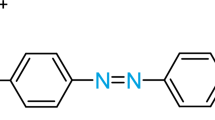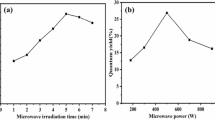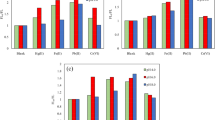Abstract
A simple microwave-assisted synthesis of nitrogen-doped carbon dots with high oxygen content (O-N-CDs) was carried out with citric acid as a carbon source and 2,4-diamino-6-methyl-1,3,5-triazine as a nitrogen source in triethylene glycol (TEG) media. It was determined by SEM analysis that O-N-CDs consisted of particles of different sizes and shapes. Transmission electron microscopy (TEM), Raman spectroscopy, and X-ray diffraction (XRD) analysis confirmed that O-N-CDs have a graphitic structure. Moreover, they showed a high fluorescence property based on the excitation wavelength. Therefore, a new fluorometric method was developed for the determination of banned food dye Sudan II by using the O-N-CDs. The proposed method was used in the determination of Sudan II in spiked spice samples. The detection limit was 0.6 mg L−1 and the linear range was 0–8 mg L−1.






Similar content being viewed by others
Data Availability
The datasets generated during and/or analysed during the current study are available from the corresponding author on reasonable request.
References
Zhang J, Yu SH (2016) Carbon dots: large-scale synthesis, sensing and bioimaging. Mater Today 19:382–393
Das R, Bandyopadhyay R, Pramanik P (2018) Carbon quantum dots from natural resource: a review. Mater Today Chem 8:96–109
Dinç S, Günhan RS (2020) Carbon dots applications in electrochemical and electrochemiluminescence sensors: Some examples of pathogen sensors. Turk J Anal Chem 2:47–54
Dinç S, Kara M (2018) Synthesis and applications of carbon dots from food and natural products: Review. J Apither Nature 1:33–37
Li L, Dong T (2018) Photoluminescence tuning in carbon dots: surface passivation or/and functionalization, heteroatom doping. J Mater Chem C 6:7944–7970
Zhu S, Song Y, Zhao X, Shao J, Zhang J, Yang B (2015) The photoluminescence mechanism in carbon dots (graphene quantum dots, carbon dots, and polymer dots): current state and future perspective. Nano Res 8:355–381
Yan F, Jiang Y, Sun X, Wei J, Chen L, Zhang Y (2020) Multicolor carbon dots with concentration-tunable fluorescence and solvent-affected aggregation states for white light-emitting diodes. Nano Res 13:52–60
Guo L, Ge J, Liu W, Niu G, Jia O, Wang H, Wang P (2016) Tunable multicolor carbon dots prepared from well-defined polythiophene derivatives and their emission mechanism. Nanoscale 8:729–734
Wang H, Sun C, Chen X, Zhang Y, Colvin VL, Rice Q, Seo J, Feng S, Wang S, Yu WW (2017) Excitation wavelength independent visible color emission of carbon dots. Nanoscale 9:1909–1915
Wen ZH, Yin XB (2016) Excitation-independent carbon dots, from photoluminescence mechanism to single-color application. RSC Adv 6:27829–27835
Zhi B, Yao X, Cui Y, Orr G, Haynes CL (2019) Synthesis, applications and potential photoluminescence mechanism of spectrally tunable carbon dots. Nanoscale 11:20411–20428
Cao L, Wang X, Meziani MJ, Lu F, Wang H, Luo PG, Lin Y, Harruff BA, Veca LM, Murray D, Xie SY, Sun YP (2007) Carbon dots for multiphoton bioimaging. J Am Chem Soc 129:11318–11319
Lim SY, Shen W, Gao Z (2015) Carbon quantum dots and their applications. Chem Soc Rev 44:362–381
Zuo P, Lu X, Sun Z, Guo Y, He H (2016) A review on syntheses, properties, characterization and bioanalytical applications of fluorescent carbon dots. Microchim Acta 183:519–542
Tuerhong M, Xu Y, Yin XB (2017) Review on carbon dots and their applications. Chinese J Anal Chem 45:139–150
Choi Y, Choi Y, Kwon OH, Kim BS (2018) Carbon dots: bottom-up syntheses, properties, and light-harvesting applications. Chem Asian J 13:586–598
Miao S, Liang K, Zhu J, Yang B, Zhao D, Kong B (2020) Hetero-atom-doped carbon dots: Doping strategies, properties and applications. Nano Today 33:100879
Zhang Q, Xie S, Yang Y, Wu Y, Wang X, Wu J, Zhang L, Chen J, Wang Y (2018) A facile synthesis of highly nitrogen-doped carbon dots for imaging and detection in biological samples. J Anal Methods Chem 7890937
Liu Y, Jiang L, Li B, Fan X, Wang W, Liu P, Xu S, Luo X (2019) Nitrogen doped carbon dots: mechanism investigation and their application for label free CA125 analysis. J Mater Chem B 7:3053–3058
Li R, Cao A, Zhang Y, Li G, Jiang F, Li S, Chen D, Wang C, Ge J, Shu C (2014) Formation of nitrogen-doped mesoporous graphitic carbon with the help of melamine. ACS Appl Mater Interfaces 6:20574–20578
Liu S, Liu R, Xing X, Yang C, Xu Y, Wu D (2016) Highly photoluminescent nitrogen-rich carbon dots from melamine and citric acid for selective detection of iron(III) ion. RSC Adv 6:31884–31888
Zhuang Q, Sun L, Ni Y (2017) One-step synthesis of graphitic carbon nitride nanosheets with the help of melamine and its application for fluorescence detection of mercuric ions. Talanta 164:458–462
Iqbal A, Iqbal K, Xu L, Li B, Gong D, Liu X, Guo Y, Liu W, Qin W, Guo H (2018) Heterogeneous synthesis of nitrogen-doped carbon dots prepared via anhydrous citric acid and melamine for selective and sensitive turn on-off-on detection of Hg (II), glutathione and its cellular imaging. Sensor Actuat B-Chem 255:1130–1138
Jiang X, Li J, Fang J, Gao L, Cai W, Li X, Xu A, Ruan X (2017) The photocatalytic performance of g-C3N4 from melamine hydrochloride for dyes degradation with peroxymonosulfate. J Photochem Photobiol A Chem 336:54–62
Yan SC, Li ZS, Zou ZG (2009) Photodegradation performance of g-C3N4 fabricated by directly heating melamine. Langmuir 25:10397–10401
Yang H, Li F, Zou C, Huang Q, Chen D (2017) Sulfur-doped carbon quantum dots and derived 3D carbon nanoflowers are effective visible to near infrared fluorescent probes for hydrogen peroxide. Microchim Acta 184:2055–2062
Molkenova A, Sh. Atabaev T, (2019) Phosphorus-doped carbon dots (P-CDs) from dextrose for low-concentration ferric ions sensing in water Optik 187 70 73
Wang W, Peng J, Li F, Su B, Chen X, Chen X (2019) Phosphorus and chlorine co-doped carbon dots with strong photoluminescence as a fluorescent probe for ferric ions. Microchim Acta 186:32
Chen Z, Wu Y, Wang Q, Wang Z, He L, Lei Y, Wang Z (2017) Oxygen-rich carbon-nitrogen quantum dots as cocatalysts for enhanced photocatalytic H2 production activity of TiO2 nanofibers. Prog Nat Sci 27:333–337
Li Q, Wang S, Sun Z, Tang Q, Liu Y, Wang L, Wang H, Wu Z (2019) Enhanced CH4 selectivity in CO2 photocatalytic reduction over carbon quantum dots decorated and oxygen doping g-C3N4. Nano Res 12:2749–2759
Liu B, Liu Y, Chen H, Yang M, Li H (2017) Oxygen and nitrogen co-doped porous carbon nanosheets derived from Perilla frutescens for high volumetric performance supercapacitors. J Power Sources 341:309–317
Lizumi Y, Yudasaka M, Kim J, Sakakita H, Takeuchi T, Okazaki T (2018) Oxygen-doped carbon nanotubes for near-infrared fluorescent labels and imaging probes. Sci Rep 8:6272
Khazaee M, Xia W, Lackner G, Mendes RG, Rümmeli M, Muhler M, Lupascu DC (2016) Dispersibility of vapor phase oxygen and nitrogen functionalized multi-walled carbon nanotubes in various organic solvent. Sci Rep 6:26208
Angamuthu R, Rajendran R, Vairamuthu R (2018) Quick microwave assisted synthesis and in vitro imaging application of oxygen doped fluorescent carbon dots. J Fluoresc 28:959–966
Wang L, Hou J, Li H, Zhao Q, Zhang F, Zhao J, Ding H, Ding L (2015) Facile synthesis of nitrogen-doped carbon dots and its application as sensing probes for serum iron. J Nanopart Res 17:457
Gümrükçüoğlu A, Başoğlu A, Kolaylı S, Dinç S, Kara M, Ocak M, Ocak Ü (2020) Highly sensitive fluorometric method based on nitrogen-doped carbon dot clusters for tartrazine determination in cookies samples. Turk J Chem 44:9–111
Taniguchi M, Lindsey JS (2018) Database of absorption and fluorescence spectra of >300 common compounds for use in photochem CAD. Photochem Photobiol 94:290–327
Gong J, An X, Yan X (2014) A novel rapid and green synthesis of highly luminescence carbon dots with good biocompatibility for cell imaging. New J Chem 38:1376–1379
Çağılcı OC, Gümrükçüoğlu A, Alp H, Vanlı E, Ocak Ü, Ocak M, (2017) A simple fluorometric method to determine Sudan I dye in spices. Karadeniz Chem Sci Technol 01:EA.1-EA.4
Thomas A, Fischer A, Goettmann F, Antonietti M, Müller JO, Schlögl R, Carlsson JM (2018) Graphitic carbon nitride materials: variation of structure and morphology and their use as metal-free catalysts. J Mater Chem 18:4893–4908
Kelarakis A (2014) From highly graphitic to amorphous carbon dots: A critical review. MRS Energy Sustain 1:E2
Siddique AB, Pramanick AK, Chatterjee S, Ray M (2018) Amorphous carbon dots and their remarkable ability to detect 2,4,6-trinitrophenol. Sci Rep 8:9770
Bhaisare ML, Talib A, Khan MS, Pandey S, Wu HF (2015) Synthesis of fluorescent carbon dots via microwave carbonization of citric acid in presence of tetraoctylammonium ion, and their application to cellular bioimaging. Microchim Acta 182:2173–2181
Arul V, Sethuraman MG (2019) Hydrothermally green synthesized nitrogen-doped carbon dots from phyllanthus emblica and their catalytic ability in the detoxification of textile effluents. ACS Omega 4:3449–3457
Dong Q, Latiff NM, Mazánek V, Rosli NF, Chia HL, Zdenek S, Pumera M (2018) Triazine- and heptazine-based carbon nitrides: Toxicity. ACS Appl Nano Mater 1:4442–4449
Zhou Y, Zhang L, Huang W, Kong Q, Fan X, Wang M, Shi J (2016) N-doped graphitic carbon-incorporated g-C3N4 for remarkably enhanced photocatalytic H2 evolution under visible light. Carbon 99:111–117
Esmeryan KD, Castano CE, Bressler AH, Abolghasemibizaki M, Fergusson CP, Roberts A, Mohammadi R (2017) Kinetically driven graphite-like to diamond-like carbon transformation in low temperature laminar diffusion flames. Diam Relat Mater 75:58–68
Calderon HA, Okonkwo A, Estrada-Guel I, Hadjiev VG, Alvarez-Ramírez F, Robles Hernández FC (2016) HRTEM low dose: the unfold of the morphed graphene, from amorphous carbon to morphed graphenes. Adv Struct Chem Imag 2:10
Shen J, Li Y, Su Y, Zhu Y, Jiang H, Yang X, Li C (2015) Photoluminescent carbon-nitrogen quantum dots as efficient electrocatalyst for oxygen reduction. Nanoscale 7:2003–2008
Ocak M, Ak T, Aktaş A, Özbek N, Çağılcı OC, Gümrükçüoğlu A, Kantekin H, Ocak Ü, Alp H (2017) Metal complexation properties of Schiff bases containing 1,3,5-triazine derived from 2-hydroxy-1-naphthaldehyde in solution. A simple spectrofluorimetric method to determine mercury (II). J Fluoresc 27:59–68
Wang Y, Wang C, Guo H, Wang Y, Huang Z (2017) A nitrogen-doped three-dimensional carbon framework for high performance sodium ion batteries. RSC Adv 7:1588–1592
Samikannua A, Konwara LJ, Mäki-Arvelab P, Mikkola JP (2019) Renewable N-doped active carbons as efficient catalysts for direct synthesis of cyclic carbonates from epoxides and CO2. Appl Catal B-Environ 241:41–51
Sun Y, Li S, Jovanov ZP, Bernsmeier D, Wang H, Paul B, Wang X, Kehl S, Strasser P (2018) Structure, activity, and faradaic efficiency of nitrogen-doped porous carbon catalysts for direct electrochemical hydrogen peroxide production R. Chemsuschem 11:3388–3395
Scardamaglia M, Susi T, Struzzi C, Snyders, Di Santo G, Petaccia L, Bittencourt C (2017) Spectroscopic observation of oxygen dissociation on nitrogen doped graphene Sci Rep 7 7960
Lisi N, Dikonimos T, Buonocore F, Pittori M, Mazzaro R, Rizzoli R, Marras S, Capasso A (2017) Contamination-free graphene by chemical vapor deposition in quartz furnaces. Sci Rep 7:9927
Sun C, Zhang Y, Wang P, Yang Y, Wang Y, Xu J, Wang Y, Yu WW (2016) Synthesis of nitrogen and sulfur co-doped carbon dots from garlic for selective detection of Fe3+. Nanoscale Res Lett 11:1–9
Şatana Kara HE (2019) Novel “turn off-on” sensors for detection of DNA-acrylamide interaction using ZnS quantum dots as a phosphorescent prob. Turk J Chem 43:125–136
Başoğlu A, Tosun G, Ocak M, Alp H, Yaylı N, Ocak Ü (2015) Simple time-saving method for iron determination based on fluorescence quenching of an azaflavanon-3-ol compound. J Agric Food Chem 63:2654–2659
Ertaş E, Özer H, Alasalvar C (2017) A rapid HPLC method for determination of Sudan dyes and Para Red in red chilli pepper. Food Chem 105:756–760
Yiğit H, İnanç AL (2017) Açıkta ve ambalajlı olarak satışa sunulan kırmızıbiberlerde sentetik boya varlığı. Akademik Gıda 15:261–268
Schummer C, Sassel J, Bonenberger P, Moris G (2013) Low-level detections of Sudan I, II, III and IV in spices and Chilli-containing foodstuffs using UPLC-ESI-MS/MS. J Agric Food Chem 61:2284–2289
Cornet V, Govaert Y, Moens G, Van Loco J, Degroodt JM (2006) Development of a fast analytical method for the determination of sudan dyes in chilli-and curry-containing foodstuffs by high-performance liquid chromatography− photodiode array detection. J Agric Food Chem 54:639–644
Liu S, Zhang X, Lin X, Wu X, Fu F, Xie Z (2007) Development of a new method for analysis of Sudan dyes by pressurized CEC with amperometric detection. Electrophoresis 28:1696–1703
Ling Y, Li JX, Qu F, Li NB, Luo HQ (2014) Rapid fluorescence assay for Sudan dyes using polyethyleneimine-coated copper nanoclusters. Microchim Acta 181:1069–1075
Li Y, Wang A, Bai Y, Wang S (2017) Acriflavine-immobilized eggshell membrane as a new solid-state biosensor for Sudan I-IV detection based on fluorescence resonance energy transfer. Food Chem 237:966–973
Hu Y, Gao Z (2020) Sensitive detection of Sudan dyes using tire-derived carbon dots as a fluorescent sensor. Spectrochim Acta A, Mol Biomol Spectrosc 239:118514.
Funding
No funds, grants, or other support was received.
Author information
Authors and Affiliations
Contributions
All authors contributed in the writing of the manuscript.
Corresponding author
Ethics declarations
Conflicts of Interest
There are no conflicts to declare.
Additional information
Publisher's Note
Springer Nature remains neutral with regard to jurisdictional claims in published maps and institutional affiliations.
Supplementary Information
Below is the link to the electronic supplementary material.
Rights and permissions
About this article
Cite this article
Ramoğlu, B., Gümrükçüoğlu, A., Çekirge, E. et al. One Spot Microwave Synthesis and Characterization of Nitrogen-Doped Carbon Dots with High Oxygen Content for Fluorometric Determination of Banned Sudan II Dye in Spice Samples. J Fluoresc 31, 1587–1598 (2021). https://doi.org/10.1007/s10895-021-02795-0
Received:
Accepted:
Published:
Issue Date:
DOI: https://doi.org/10.1007/s10895-021-02795-0




